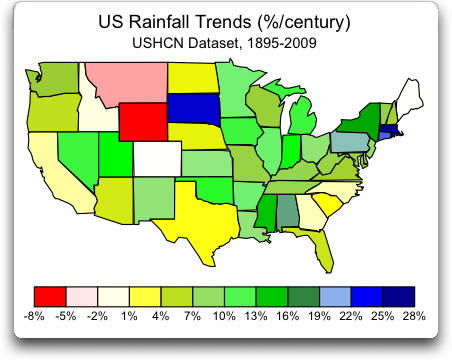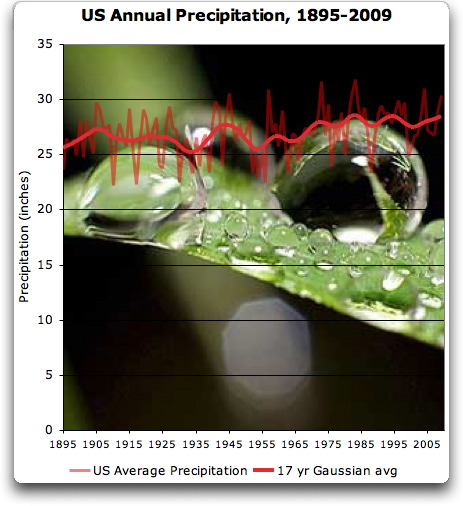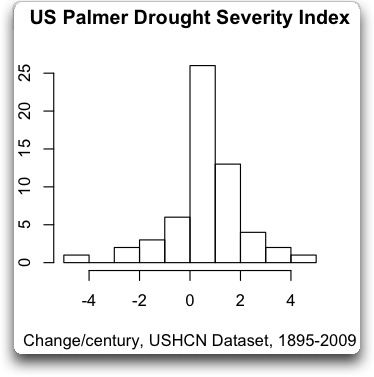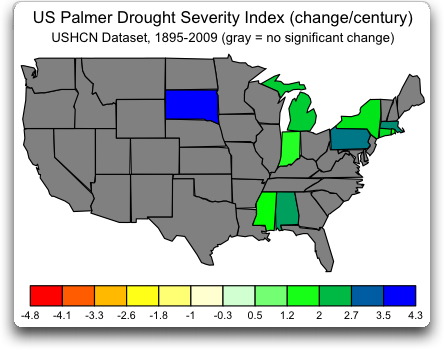I have long claimed that "a warmer world is a wetter world". I have said this without any actual data, based solely on the following logic.:
Increased temperature - > increased evaporation - > increased precipitation.Today I graphed the numbers for the US precipitation. I used the USHCN state-by-state precipitation database, which also includes area-averaged values for regions of the US, and for the US itself.
First, here is the change in precipitation in the US since 1895:
Since the both the US and the globe have warmed since 1895 it seems that a warmer US is a wetter US. However, precipitation is spotty and unevenly distributed. One area can be very wet while a nearby area is dry, so what about the precipitation in each of the states?
The USHCN database contains state data. Since there are drier states and wetter states, I looked at the percentage increase in precipitation rather than the absolute change in precipitation. Here are the state-by-state results:

Instead, all of the southwestern states have increased rainfall. The main area with decreased rainfall encompasses the Rocky Mountain states in the central Northwestern US.
My conclusions? Precipitation is indeed spotty. A warmer US is indeed a wetter US. And there is no decrease in the Southwestern US data which would show that the great northern desert belt is moving polewards. So either the desert belt is not moving poleward, or the movement is offset by the overall increase in precipitation.
[UPDATE] Some commenters have correctly pointed out that I have only shown the precipitation, which doesn't show the change in droughts. This is because droughts are a combination of soil moisture, temperature, rain, and other factors. This is measured by the Palmer Drought Severity Index (PDSI). The PDSI index values have the following meaning:
-4.0 to less (Extreme Drought)I used the USHCN database cited above to look at the state-by-state trends per century in the PDSI. Note that these are not the average PDSI values by state, which are without exception in the range -1.9 to +1.9 (near normal). Figure 3 is a histogram of the trends per century. A "histogram" shows the number of states (left scale) that have a certain trend range (bottom scale).
-3.0 to -3.9 (Severe Drought)
-2.0 to -2.9 (Moderate Drought)
-1.9 to +1.9 (Near Normal)
+2.0 to +2.9 (Unusual Moist Spell)
+3.0 to +3.9 (Very Moist Spell)
+4.0 to above (Extremely Moist)
The trend in most of the states (39 out of 48) is toward less drought (increasing PDSI). However, most of the trends (32 of 48) are between 0 and +2.0, which is not a large change. As a result, most of the trends are not statistically significant. Figure 4 shows the significant state trends:
As you can see, despite the warming of the last 115 years shown in the USHCN dataset, while some of the PDSI trends have decreased, the only statistically significant changes in the PDSI are positive (less drought).
The IPCC models say that increasing warmth will lead to increasing drought, particularly in the mid-latitudes:
In a warmer future climate, most Atmosphere-Ocean General Circulation Models project increased summer dryness and winter wetness in most parts of the northern middle and high latitudes. Summer dryness indicates a greater risk of drought.Despite these model predictions, we have seen no such increase in drought in the US. For most of the US, there has been no statistically significant change in the PDSI index showing the number and strength of droughts in most US states. And where there has been a statistically significant change, it is in the direction of reduced drought.






neat...